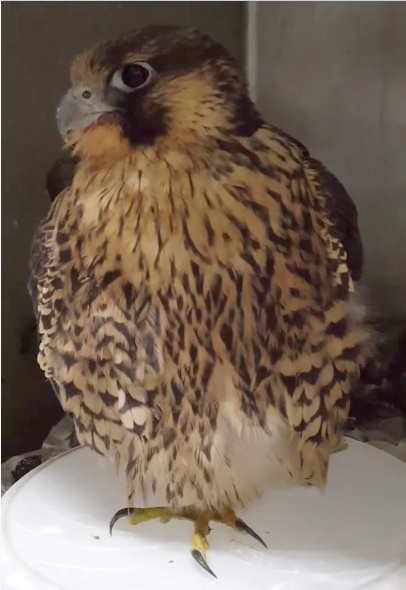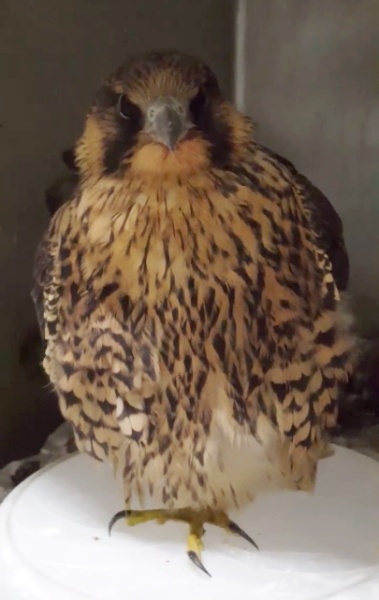
Late yesterday afternoon the ARL Wildlife Center posted a short video and this update on their Facebook page. Click here or on the photos to see the video.
Peregrine Update:
It’s a boy! X-ray reports have revealed that the falcon is a male. We have also received the results from initial blood tests which have all been normal. We are still waiting for the reports from the lead test, but the bird is gaining weight & his flight feathers continue to grow. We will continue to provide public updates on the peregrine as soon as new information develops, but are unable to respond to individual inquiries about this patient.

(Posted on Facebook by Animal Rescue League Shelter & Wildlife Center on Wednesday, July 8, 2015, approximately 4:30pm)
NOTE: As you can see, my news cycle is typically 13-15 hours later than ARL’s Facebook posts. For up-to-the-minute news from ARL, check their Facebook page at Animal Rescue League Shelter & Wildlife Center. Their page is public. You don’t have to join Facebook to see it.
p.s. Here’s an informative July 9 article from Pitts’ University Times and standing on one leg is normal.
He looks like a little golden feathered Christmas tree ornament.
Thanks for the update. He is beautiful.
Thank you for the update. I am glad I found your page.
isn’t he beautiful. Thank you and ARL for keeping track and taking care —
Aw…Hi Fuzzy!! You are beautiful!! Now we know why you did all the squawking when you were hungry, because you are a male!! hahaha You are doing great and we all love you. You folks have done a wonderful job taking care of him. Thank you!! <3
I’m curious how xrays show sex in a bird – I was expecting genotyping instead. Do you know what features they look for in xrays?
Paige, I don’t know how they tell sex using xrays.
Awesome news. I just know he will be ok. Thank you for the continued updates.
The nice thing about your posts (late or not), is that I can always go back to your blog and find what I want to see again – a lot easier than Facebook. Thanks for posting. Hoping Silver will get a clean bill of health and can be released.
What a handsome boy! I’m glad Fuzz is doing so well! Thanks to the Animal Rescue League Shelter and Wildlife Center for taking such good care of him. He sure has touched a lot of hearts.
The shape of the pelvis between a male and female human is different due to the ability to birth a child. Maybe it is the same for birds with laying eggs?
Lori, I do not know what the skeletal differences would be between male and female birds and have not found anything online.
I am glad he is doing so well.Such a handsome falcon.Thanks so much.
Aww…thanks Kate. This is my first year following the Peregrines & have loved it. It has been a pleasure meeting you. I have learned so much. Thank you!
I looked it up — you know that Xrays can show soft tissues as well as bone structure, right? Male birds have 2 testes, but they are internal, located above the kidneys. Female birds, interestingly enough, usually only have one functional ovary – on the left. They start life with 2 but the right ovary & oviduct don’t grow.
Scientists aren’t certain why, but it may reduce weight and make flying easier? A mystery! Just like human girl babies and other mammals, a female bird, when she is born (hatched), already has ALL the egg cells in that ovary that she will ever have! The male, of course, produces sperm throughout his reproductive life.
I don’t believe male Peregrines have a phallus, although a few birds such as chickens, ostriches, and, famously, DUCKS, do have one. Quite different from the mammalian male organ! Peregrines and other raptors mate by pressing cloacas together (the cloacal kiss!)
So, presumably Silver’s Xrays (which may or may not include an ultrasound) showed a pair of healthy bean-shaped testes above his kidneys, rather than a single large left ovary. LOL and no phallus! Long may he live, and hopefully get to fly free and enjoy them with a nice female Peregrine when he’s a little older 🙂
PS – you know what the definition of a Capon is, right? A “Roostah that Usetah!”
Oh, forgot the source: Winged Wisdom magazine
http://www.birdsnways.com/wisdom/ww32eiv.htm
http://www.birdsnways.com/wisdom/ww33eiv.htm
Found this on the Pitt Times (University of Pittsburgh newpaper).
“Of greater concern, however, is its lack of beak-eye coordination. A veterinary exam revealed no apparent visual impairment, but the bird “misses” when it reaches for food.” Argall said that although the bird is perching, the foot remains weak, which could interfere with its ability to live in the wild. Because peregrines hunt by catching small birds in flight, “they need both sets of talons,” Argall said.
http://www.utimes.pitt.edu/documents/V47N22.pdf